Sand Casting of Cast Iron A Comprehensive Overview
Sand casting is an age-old method that has stood the test of time in the metalworking industry, particularly in the production of cast iron components. This technique, celebrated for its simplicity, versatility, and cost-effectiveness, has been widely adopted across various sectors, including automotive, aerospace, and manufacturing.
The Basics of Sand Casting
Sand casting involves several key steps pattern making, molding, pouring, and finishing. The process begins with creating a pattern, often made from wood or metal, which serves as a replica of the desired final product. This pattern is then used to form a mold made from a mixture of sand and binder, typically clay or resin. The choice of sand, often silica sand, is crucial as it impacts the mold's strength and ability to withstand high temperatures.
Once the mold is prepared, molten cast iron is poured into the cavity created by the pattern. The molten metal then cools and solidifies, taking on the shape of the mold. After cooling, the sand mold is broken away to reveal the cast iron component. The final step involves finishing, which may include cleaning, grinding, or machining to achieve the desired surface finish and dimensions.
Advantages of Sand Casting Cast Iron
One of the primary advantages of sand casting is its ability to produce complex shapes. The flexibility of sand molds allows for intricate designs that may be challenging to achieve with other casting techniques. Additionally, sand casting can accommodate a wide range of sizes and weights, from small, detailed components to large, heavy parts.
Cost-effectiveness is another significant benefit. The materials used in sand casting, primarily sand, are abundant and inexpensive. This makes sand casting an economical choice, especially for producing large quantities of parts. Furthermore, the process can be easily adapted for both low and high volume production, providing a practical solution for varying production needs.
The thermal properties of cast iron also make it an excellent material for sand casting. Cast iron, known for its good fluidity, allows for easier pouring and filling of the mold. It also possesses superior wear resistance, which is particularly advantageous in applications where components are subject to high stress and friction.
sand casting cast iron

Applications of Cast Iron in Sand Casting
Cast iron components produced through sand casting are used in a myriad of applications. In the automotive industry, cast iron is commonly used for engine blocks, cylinder heads, and exhaust manifolds due to its strength and ability to dissipate heat effectively. In construction, cast iron is frequently used for pipes, fittings, and architectural elements, appreciated for its durability and aesthetic appeal.
Moreover, the aerospace sector has begun to explore cast iron's potential in specific applications, leveraging its mechanical properties to produce high-performance components. Its ability to withstand extreme temperatures and pressures makes it suitable for particular aerospace parts, though it's more commonly associated with non-structural applications.
Challenges in Sand Casting Cast Iron
While sand casting has numerous advantages, it also presents certain challenges. One of the significant issues is the potential for defects such as porosity, shrinkage, and misalignment during the casting process. These imperfections can compromise the integrity and performance of the final product.
To mitigate these issues, manufacturers often invest in high-quality materials and advanced techniques. For instance, incorporating additives in the sand can enhance its bonding properties and reduce the likelihood of defects. Additionally, continuous monitoring of the casting process and thorough inspection of the final products are essential in maintaining quality standards.
Conclusion
In conclusion, sand casting of cast iron remains a vital and robust process in modern manufacturing. Its ability to produce complex shapes at a low cost, combined with the favorable properties of cast iron, ensures that it will continue to be a preferred method for fabricating a wide range of components. While challenges exist, ongoing advancements in technology and techniques are helping to refine the process, making sand casting an even more reliable option for industries worldwide. As the demand for skilled craftsmanship and precision engineering grows, the importance of sand casting in producing high-quality cast iron components will undoubtedly endure.
Post time:Ное . 27, 2024 15:24
Next:A Step-by-Step Guide to Mastering Sand Casting Techniques for Beginners
